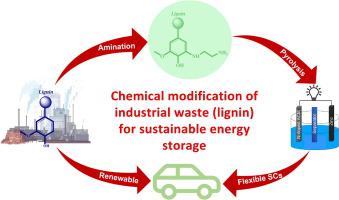Journal of Colloid and Interface Science ( IF 9.4 ) Pub Date : 2023-03-11 , DOI: 10.1016/j.jcis.2023.03.056 Jiajia Guo 1 , Syed Comail Abbas 2 , Hai Huang 1 , Zifeng Hua 1 , Md Manik Mian 2 , Shilin Cao 1 , Xiaojuan Ma 1 , Yonghao Ni 2

|
Developing highly efficient, sustainable carbon cathodes is essential for emerging Zn-ion hybrid supercapacitors (ZICs). Herein, lignin's novel chemical modification (amination) has been developed to produce high quantity pyrrolic-N moieties as active sites. Furthermore, chemically modified amine moieties in lignin are vital as a natural self-activating template to generate hierarchical porosity in the 2D (graphene-like) architecture with exceedingly high surface area (2926.4 m2g−1). The rationally introduced dominated pyrrolic-N moieties boost the Zn-ion storage capacity and reaction kinetics due to the dual energy storage mechanism and efficient charge transfer between pyrrolic-N and Zn+2 ions. Furthermore, the pyrrolic-N species are energetically favorable for the adsorption of Zn+2 ions by the formation of N-Zn+2 chemical bonds. Besides, the nitrogen oxides reduce the intrinsic resistance and induce a more polarized surface, resulting in high wettability and efficient transfer of electrolytes into the pores of hydrophobic carbon materials. Subsequently, the chemically modified lignin-derived activated carbon material (Chem-ACM) as a cathode in ZICs delivers a high capacity of 161.2 mA h g−1 at 1 A g−1 with the admirable energy density of 106.7 W h kg−1 at 897 W kg−1 and excellent retention capacity (94%) after 10,000 cycles. Mainly, the assembled quasi solid-state ZICs using Chem-ACM retains the remarkable storage capacity (202 mA h g−1 at 0.2 Ag−1) even at a high bending angle. Notably, the Chem-ACM has been further employed in symmetric supercapacitors as an electrode, and it displays exceptional specific capacitance of 354 Fg−1 at 0.5 Ag−1 with tremendous energy (43.5 W h kg−1) and the power density (0.53 kW kg−1). Additionally, the charge storage capability of Chem-ACM is positively dependent on high nitrogen contents, and it is extrapolated that pyrrolic-N moieties are dominant active sites. Hence, the designed amination-assisted biocarbon synthesis provides a new way to prepare high nitrogen-containing biocarbon for ZICs and further understand pyrrolic-N species' impact on Zn-ion storage.
中文翻译:

用于锌离子超级电容器的胺化木质素衍生的吡咯氮主导碳材料的合理设计
开发高效、可持续的碳阴极对于新兴的锌离子混合超级电容器 (ZIC) 至关重要。在此,木质素的新型化学修饰(胺化)已被开发出来以产生大量的吡咯-N 部分作为活性位点。此外,木质素中经过化学修饰的胺部分作为天然自激活模板至关重要,可在具有极高表面积 (2926.4 m 2 g -1 ) 的 2D(类石墨烯)结构中生成分级孔隙率。由于吡咯-N 和 Zn +2之间的双重储能机制和有效电荷转移,合理引入的主导吡咯-N 部分提高了 Zn 离子存储容量和反应动力学离子。此外,吡咯-N 物种通过形成N -Zn +2化学键在能量上有利于 Zn +2离子的吸附。此外,氮氧化物降低了本征电阻并诱导了更极化的表面,从而导致高润湿性和电解质有效转移到疏水碳材料的孔隙中。随后,化学改性的木质素衍生活性炭材料( Chem-ACM) 作为 ZIC 的阴极,在 1 A g -1时提供 161.2 mA h g -1 的高容量,在897 瓦公斤-110,000 次循环后具有出色的保留容量 (94%)。主要是,使用 Chem-ACM 组装的准固态 ZIC即使在高弯曲角度下也能保持显着的存储容量(在 0.2 Ag -1时为 202 mA h g -1 )。值得注意的是,Chem-ACM 已进一步用于对称超级电容器作为电极,它在 0.5 Ag -1时显示出 354 Fg -1的特殊电容,具有巨大的能量(43.5 W h kg -1)和功率密度(0.53千瓦公斤-1). 此外,Chem-ACM 的电荷存储能力与高氮含量正相关,据推测吡咯-N 部分是主要的活性位点。因此,设计的胺化辅助生物碳合成为 ZICs 制备高含氮生物碳提供了一种新方法,并进一步了解吡咯-N 物种对锌离子储存的影响。





















































 京公网安备 11010802027423号
京公网安备 11010802027423号